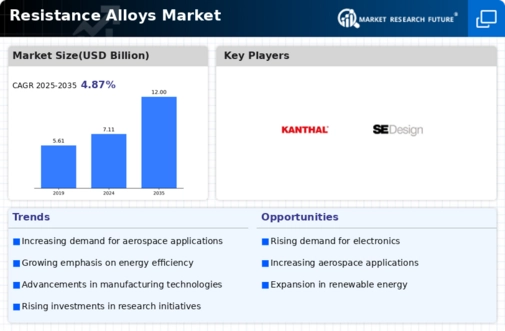Market Trends
Key Emerging Trends in the Resistance Alloys Market
The Resistance Alloys Market is currently experiencing dynamic trends that showcase the essential role of resistance alloys in various industries, particularly in electrical and heating applications. One significant trend is the increasing demand for resistance alloys in the electronics and electrical engineering sector. As electronic devices become more sophisticated, the need for materials with precise electrical resistance and stability is growing. Resistance alloys, such as nichrome and constantan, are favored for their consistent performance and durability, making them crucial components in resistors, heating elements, and electrical wires. This trend aligns with the expanding electronics market and the continuous quest for reliable materials that meet the stringent requirements of modern electronic applications.
Moreover, the heating elements industry is a major contributor to the momentum in the Resistance Alloys Market. Resistance alloys are widely utilized in the manufacturing of heating elements for household appliances, industrial furnaces, and specialized heating devices. The ability of resistance alloys to generate controlled heat at high temperatures makes them indispensable in applications where precise temperature control is critical. This trend reflects the importance of resistance alloys in contributing to energy-efficient and durable heating solutions across various sectors.
Technological advancements in alloy composition and manufacturing processes are shaping market trends in the Resistance Alloys Market. Innovations such as alloy modifications, improved heat treatment techniques, and advancements in alloy production technologies are enhancing the performance characteristics of resistance alloys. This trend is essential for meeting the evolving needs of industries where resistance alloys are applied, ensuring that they withstand harsh conditions, offer optimal electrical resistance, and exhibit longevity in service. The industry's focus on continuous innovation is driving the development of resistance alloys that cater to diverse and demanding applications.
The automotive sector's influence on resistance alloy trends is significant, with these alloys finding applications in various automotive components. Resistance alloys are utilized in automotive heating systems, sensors, and electrical components that require stable electrical properties and corrosion resistance. The increasing electrification of vehicles and the demand for advanced electronic systems in automobiles contribute to the growing use of resistance alloys in the automotive industry. This trend aligns with the automotive sector's push towards enhanced efficiency, performance, and sustainability.
Sustainability considerations are becoming increasingly important in shaping market dynamics in the Resistance Alloys Market. Manufacturers are exploring sustainable sourcing of raw materials, eco-friendly production processes, and recyclable alloy options. This trend aligns with the global movement towards environmentally responsible practices, reflecting the industry's commitment to reducing its environmental impact and meeting consumer expectations for sustainable materials.
E-commerce is playing a role in reshaping the distribution channels of resistance alloy products. The convenience of online platforms for product discovery, comparison, and purchase is influencing buyer behavior in the industrial materials sector. Manufacturers and distributors are adapting to this trend by establishing a robust online presence, providing detailed product information, and offering efficient delivery services. The accessibility of resistance alloy products through e-commerce platforms contributes to increased market reach and customer engagement.
Regulatory considerations and adherence to safety standards are pivotal factors shaping market dynamics in the Resistance Alloys Market. As resistance alloys are used in critical applications where safety and reliability are paramount, compliance with regulations related to electrical safety, materials performance, and industry standards is crucial. Companies are investing in research and development to ensure that their resistance alloy products meet or exceed regulatory requirements, providing assurances to industries that rely on these materials.
Strategic collaborations and partnerships are emerging as trends in the Resistance Alloys Market. Companies are exploring synergies through joint ventures, alliances, and collaborations to enhance research, development, and commercialization efforts. The collaborative approach allows for the exchange of expertise, resources, and market insights, fostering innovation and ensuring the continuous growth of the resistance alloys industry.






Leave a Comment